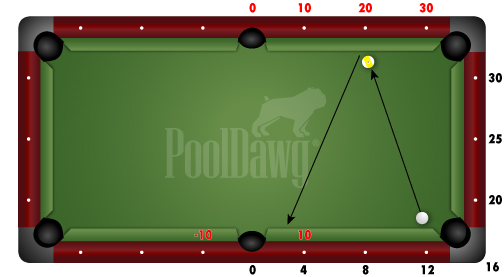In my life I have been fortunate enough to travel and during those travels I learned two or three new banking systems that I have never seen before and wanted to share one of them with you in this article. This one comes from Japan. We are going to learn the 4 hook system. This works for banks to the side pocket where the cue ball is below the object ball. The system numbers are in the diagram below.
What this system gives you is a basic architecture to look at a straight in bank and know for certain where it will hit the second rail. Once you know that, you can make speed and spin adjustments to pocket the ball.
What this system will give us is the exact place on the second rail the object ball will hit, based on a medium speed hit for a straight shot into the side rail. With this knowledge you can shorten the angle by hitting the shot harder, widen the angle by hitting the shot softer, and add spin to magnify these effects.
Let's check out this example:

As you can see here, the straight shot goes from 20, right at 16. The 20 to 20 leads to the side pocket, so we are going to be 4/10ths of a diamond long at the side pocket.
One thing to keep in mind is that the first rail numbers are the same on the second rail. The only numbers that are different are the cue ball starting numbers. These numbers are in red in the diagram.
To make this bank we need to hit the shot harder, and depending on how the rails are playing, use left spin on the cue ball to add a touch of right spin on the object ball to help hold it up.
How much spin or speed to use really is dependent on the table you are playing on and your stroke. To learn how to use this system, first learn the speed that you need to get the numbers to work. Now using that as a reference you can now hit harder or softer to see how many numbers you can adjust on these paths. Finally add spin to see what your limits are.
Let’s look at another example:

In this case we are coming from 12 into 20. The natural straight in bank goes to 8 in the red numbers. So to make this bank we have to open the angle a little. We can hit this softer and use a little spin.
Just to be complete, to find out if the straight in bank is going to be short or long, we look at the cue ball start number. Since in this case it is 12, then any first rail number higher than 12 means the bank will be short, and any first rail number less than 12 means the bank will be long
Fiddle around with this system for a while and I’m sure you will start to like it. I sure do.
Play well and see you on the road.
- RELATED ARTICLES
- How to Make Kick and Bank Shots – By Florian "Venom" Kohler
- Banking Basics – By Jennifer Barretta
- K.I.S.S (Keep It Simple, Silly) – By Samm (Diep) Vidal Claramunt